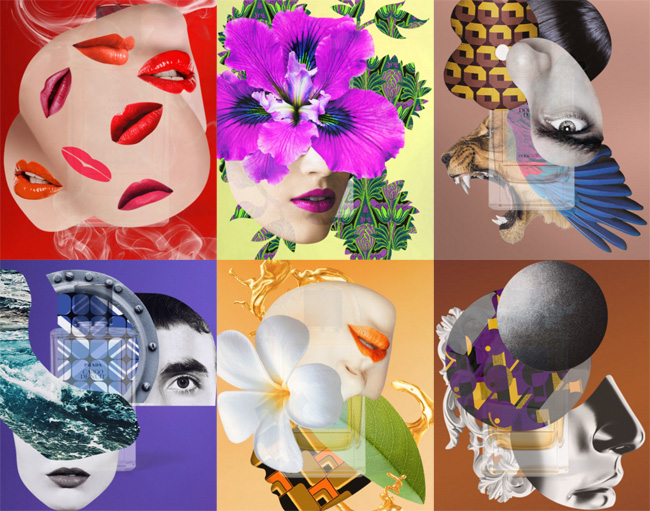The marketing behind luxury fragrances is progressively being adapted to the new era, as appealing to the senses becomes paramount, writes Mark Izatt of Cream UK.

“ Some niche fragrance brands are bucking the trend by opting for an androgynous approach ”
But it hasn’t always been like this.
Before the mid-nineteenth century, there was no concept of producing men’s and women’s fragrances separately. It was common to smell blousy florals on men and smoky woods on women. As the 20th century progressed and fragrance advertising proliferated, masculine and feminine fragrances became increasingly polarised, until reified by Jean Paul Gaultier’s torso-shaped bottles for Le Male and Classique.
Fragrances at lower price points persist with these heavily gendered campaigns, using celebrity spokesmodels to appeal to old ideals of femininity and masculinity. Lancome’s sweet and floral La Vie est Belle, for example, employs Julia Roberts, all fresh blow-dry and white teeth on a sparkling background. Even the perfume is dyed pink, with a glittering bow on the bottle. Dior’s peppery Sauvage casts a macho Johnny Depp standing in the desert, pulling up his sleeves to reveal tattoos and gothic jewellery.
But some niche fragrance brands are bucking this long-standing trend by opting for an androgynous approach to marketing. Minimalist bottles avoid colours heavy with gender connotation. Packaging features surreal holographic collages that express scent in purely conceptual terms. Product names are often abstract, or focus on ingredients, with no ‘pour homme’ or ‘pour femme’ in sight. D.S. & Durga’s Silent Grove and Debaser, or Vilhelm Parfumerie’s The Oud Affair and Morning Chess are prime examples, as are Prada’s new line of private blends including Cargo De Nuit, Purple Rain, Tainted Love, and Marienbad.
“ The lifestyle & fragrance preferences of younger consumers are increasingly impacting marketing approaches ”
Far from the aspirational approach tied up with using celebrity models, these brands dismantle the heavily gendered imagery and bring the focus back to scent itself. It is superior ingredients and artistry which make perfumes luxurious, so it seems logical to bring these to the fore. Communicating the sensual and emotional possibilities of a fragrance may be enough to create a desire to sample it, without alienating those who do not aspire to traditional masculinity or femininity.
A recent article by Luxury Society, on the rise of ‘sensploration’ as a rising trend, highlighted how the lifestyle and fragrance preferences of younger consumers are increasingly impacting brand marketing approaches.
As explored in the piece, German firm Symrise recently carried out research finding that Millenials and Generation Z, having grown up in a digital world, approach fragrance consumption differently. Brands are innovating to stay on top of these trends in an attempt to produce more targeted products for the consumer.

Italy’s Prada Parfums was spotlighted as one example, choosing to illustrate the contradictory qualities of the “surreal” scents in its Olfactories collection through a series of still life collages, rather than more traditional celebrity endorsement.
For each of its ten “potent concoctions of the unexpected,” Prada created a collage to interpret the notes in a tangible way. With each scent sold in the same rectangular glass bottle, this digital campaign created a visual means for consumers to explore the range.
In fashion and beauty marketing at large, brands challenging the boundaries of gender and sexuality are garnering plenty of positive attention. Last year, Tiffany grabbed headlines with an engagement ring campaign celebrating same-sex marriage, while Barneys and &OtherStories; chose to cast trans models in photographic campaigns. Calvin Klein’s new campaign for fragrance best-seller CKIn2U depicts heterosexual and homosexual couples, and the brand’s star-studded new underwear campaign is more about self-love than seduction, cleverly avoiding specific sexualities.
“ There is room for similar bravery when marketing luxury perfume ”
There is room for similar bravery when marketing luxury perfume – a product which doesn’t come with the restrictions of, say, a dress that only comes in women’s sizes, or makeup which would evoke shock from the masses if seen on a male model.
The forefront of fashion no longer sees gender roles as gospel, and the beauty industry is beginning to follow suit. Luxury fragrance will be the first to benefit from this shift, moving liberally forward whilst harking back to a time when fragrance was unrestricted by gender, celebrating sheer sensual pleasure above all else.
To further investigate the changing luxury landscape and brand innovation on Luxury Society, we invite your to explore the related materials as follows:
– Sensploration: The Luxury Trend Taking Over
– Is The Definition Of Luxury Changing?
– Focus: Luxury 3.0










